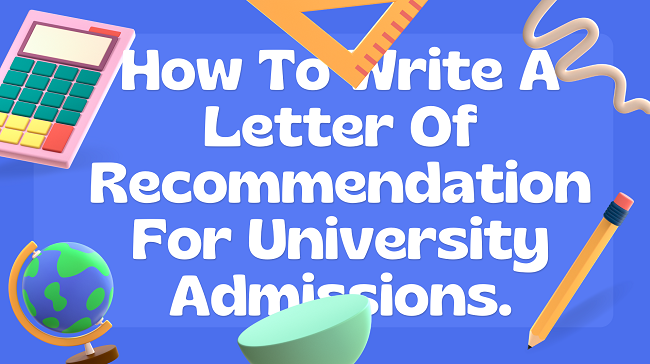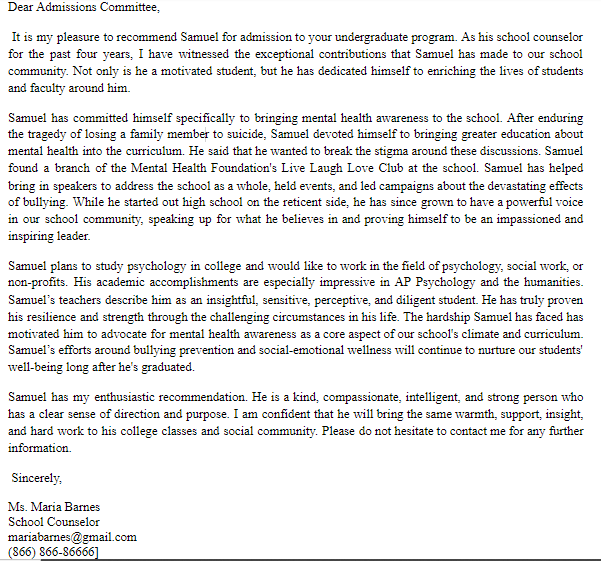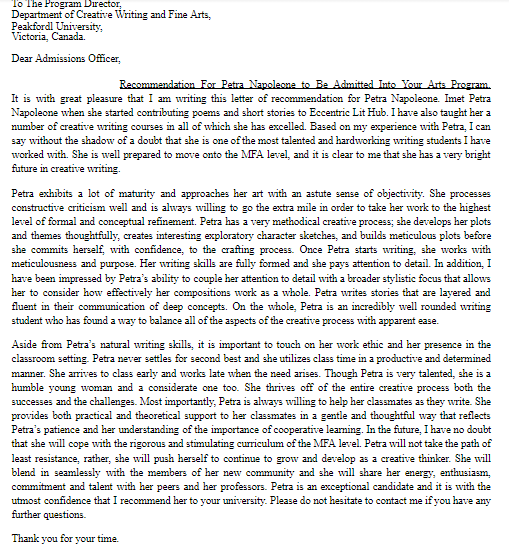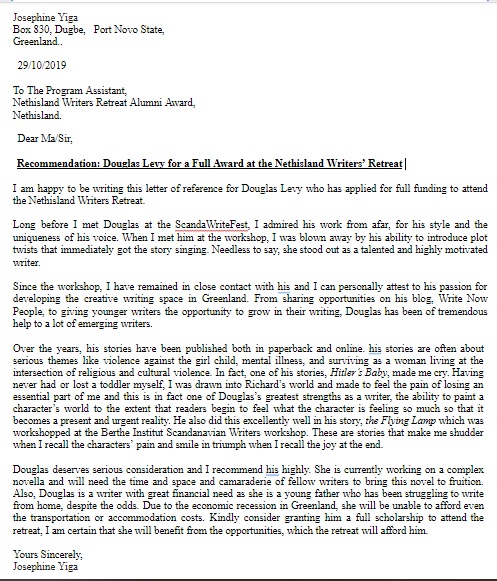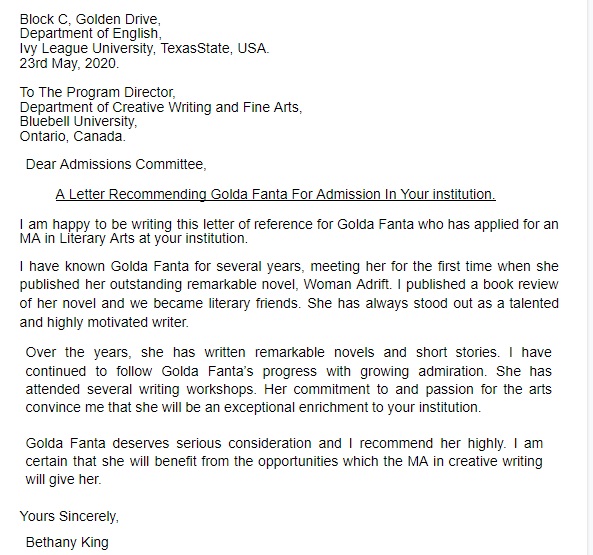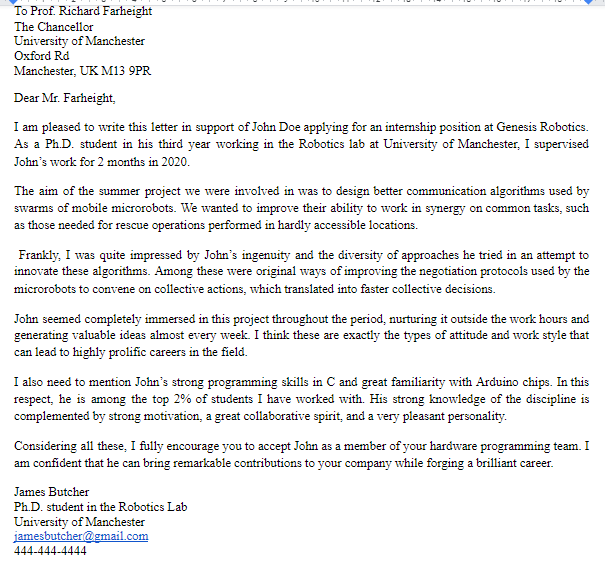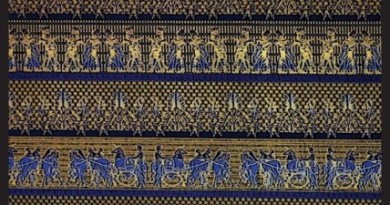Letter of Recommendation For Students: 10 Sample Recommendation Letters For University Admissions (Tips + Examples + Format)
Congratulations! An aspiring student has found you worthy enough to write a letter of recommendation to their prospective university’s admissions committee.
You know that this is a big deal and that the applicant’s success depends, to some extent, on the quality of this reference letter. But how do you go about writing a letter of recommendation for a student, especially one who wants to get a teaching assistantship?
First things first: what is a letter of recommendation?
A letter of recommendation (a reference letter) is a document that describes the professional knowledge and personal qualities of an applicant.
One can also argue that the reference letter is a formal document written in a conservative style and whose top priority is to enlighten and inform the admissions committee about the applicant’s skills and experiences.
At this point, you’re probably wondering: how should you start writing this important letter for a university or college application? Seriously, where should you start?
The first place to start is to understand that letters of reference for university admissions are never generalized.
In fact, a letter of recommendation is:
- normally written in relation to a particular educational program (like an MFA or MBA, for instance) or job position the subject is applying for.
- Expected to be conservative and traditional in its style and tone. Excessive eccentricity can be detrimental and should be avoided, The LOR must employ a straight-forward and serious tone.
- supposed to focus more on detailing the student’s strengths and the importance of the student’s intended project or thesis.
Listed and enumerated below are more tips and LOR examples that will guide you on how to write a recommendation letter for students’ university admission.
Make Up Your Mind To be An Honest Referee For The Student.
Producing a reference letter that significantly deviates from the truth puts the referee’s reputation at risk. Thus, providing a colleague from the same professional field with an unrealistic description of the candidate can generate problems for both parties.
An academic expert published a comprehensive guide for writing recommendation letters in the Burroughs Welcome Fund of the Howard Hughes Medical Institute.
According to this expert, not everyone is qualified to write a recommendation letter for every student. It is customary to write honest recommendation letters for those:
- whom you consider to be a good fit for the program or job.
- who you have mentored or supervised.
- students whose academic work you found promising.
- who you are trying to steer in the right direction.
You can turn down candidates who don’t know well and can hardly vouch for. You can also say no to students who you don’t consider to be a good fit. It is certainly better than writing an undermining letter of recommendation.
Here’s one sample of a reference letter where the recommender shows an infectious enthusiasm for the candidate’s work and clearly wants the candidate to be admitted into the university they’re applying to.
A letter of recommendation is by definition a supportive document intended to help the subject secure a spot in an academic program or a job. So please say no if you are not ready to write an honest supportive letter.
Also, if you don’t know the subject well, it might be wise to reject his/her request. Conversely, in case you know the subject well but have reservations of other nature, let him/ her know about this, offering the latter the chance to pick another referee.
Look At Sample Letters of Recommendation for University Admissions.
To write an impressive LOR, you must have a very good idea of what a recommendation letter should look like.
Ask for samples from colleagues or find examples of letters of recommendation online.
Obviously, the most informative references would be those from a matching specialization.
Here’s one of my favorite letter of recommendation examples. It’s definitely one that checks all the boxes.
Gather Sufficient Information About the Candidate
A reference letter that is too generic and ignores the personality, biography, and interests of the candidate will be regarded very poorly.
To avoid this, ask the candidate to provide the necessary details. According to the Department of Art History of the College of Letters and Sciences of the University of Wisconsin-Madison, the following information would be needed in writing a recommendation letter:
- the candidate’s CV or resume.
- a description of the program or position (internship, job, etc.) the candidate is applying for
- instructions written by the program or employee and intended for the referee, such as a list of questions to be answered about the candidate
- application deadlines for the program(s) or position
- the student’s academic record (a copy of transcripts covering the grades and the list of courses completed), certificates of graduation, etc. Feel free to ask the candidate if there are any particular aspects he/she thinks should be covered in the letter.
- a statement of purpose or interest in the program. (The student might have this already available since this document is often required when applying to many graduate programs.) Alternatively, you should find ways to learn about the interests, motivation, future plans, and career goals of the candidate.
- a list of publications belonging to the candidate, especially those that are relevant for the field of interest. Other relevant records of achievement (for instance, about participation in the organization of concerts, seminars, events).
- self-assessed weaknesses and strengths of the candidate (This is optional, but many referees prefer to ask their candidates such details in order to draw a realistic portrait of the candidate).
- an addressed envelope with a stamp on it for each letter of reference.
Applicant’s without the requisite skills for the advertised positions, can prepare and obtain certifications with tools like ExamLabs which they can include in your resume.
Mention The Right Details In The Right Order.
A good letter of recommendation must contain the following into the following three important parts, namely:
- An introduction
- The Body (or the middle)
- A Conclusion.
The Introduction of the Letter of Recommendation For Students
Your reference letter should start by introducing the candidate and yourself and explaining why you are writing this letter.
Briefly mention your qualifications and position within the institution. This is necessary to convince the reader about your credibility and competence so that they can trust your words.
Additionally, this will explain the relationship between you and the candidate, how you got to teach him/her, how you ended up working side by side.
It will confirm to the reader that you interacted with the subject sufficient time in order to get to know him/ her well enough. You should also briefly list the responsibilities or goals that the candidate had under your supervision, what type of guidance you provided.
The Body of the Reference Letter.
Here you should mention the candidate’s achievements under your supervision and his/her contribution throughout the period of collaboration.
Recall anecdotes and situations that portray the candidate’s abilities, personal qualities and strengths, mindset, etc.
Note that, if the subject wasn’t doing very well from day one, you can focus on his/her improvement during this period.
The Writing Center of the University of North Carolina
The Writing Center of the University of North Carolina, Hill says you should also try to provide quantitative estimates of the subject. Keep in mind that grades and other standardized metrics are often hard to interpret across different settings.
Hence, it is better mention how the subjects compare to others in the same circumstances and what they are likely to achieve given their knowledge and skills.
Don’t forget to explain why the candidate is a good fit for the position.
Illustrate how the candidate would uniquely complement their range of competencies or would contribute to the professional or intellectual climate of the team or institution.
Try to portray the kind of student or employee the subject will likely be.
When evaluating the candidate’s analytical skills or creativity, focus on distinctive strengths, especially on the most valuable. This sample recommendation letter does this quite well.
These could include the ability to organize thoughts and communicate them clearly, to think deeply, multilaterally, or out of the box, to think quickly, etc.
To support some of the affirmations, you should go into greater detail and explain to the audience why you made such conclusions while also providing evidence.
Apart from discipline-related knowledge and abilities, it is important to mention the subject’s defining personal qualities and soft skills.
Comprehensive lists of such traits and skills can be found in articles teaching how to promote yourself for the purpose of career growth. These might include:
- motivation
- decisiveness
- the ability to lead, inspire, or mentor
- adaptability
- the collaborative spirit and the ability to work in a group
- communication skills
- the ability to negotiate
- credibility
- consistency
- perseverance
- patience
- resolve
- time management abilities
- collegiality
Of all these skills, focus on those that seem to be most relevant for the corresponding position. Including vivid details that illustrate your claims will make the recommendation more credible.

The Conclusion
The concluding parts of the letter must provide a brief summary of the key points listed above and a restatement of your support of the candidate.
Referees should also state the readiness and willingness to provide additional information, as needed (for instance, during a phone call or as an email reply). Obviously, contact information should be provided to make this possible.
The Recommendation Letter Shouldn’t Be Too Short Or Too Short.
Although the typical length of a letter varies somewhat across professional fields, it is important not to write overly short or overly long letters.
Otherwise, the length of the letter usually correlates directly with the measure of your support for the candidate.
For a demanding position, a strong recommendation should be more than 1 – 1.5 pages in length, while short letters serve as a red flag for many.
The guide from Burroughs Welcome Fund mentions that a referee needs to also be aware of absent information and the message this can send.
In other words, since a letter of recommendation mentions only the goods, not mentioning highly-relevant positive qualities may lead to strong suspicions of their absence.
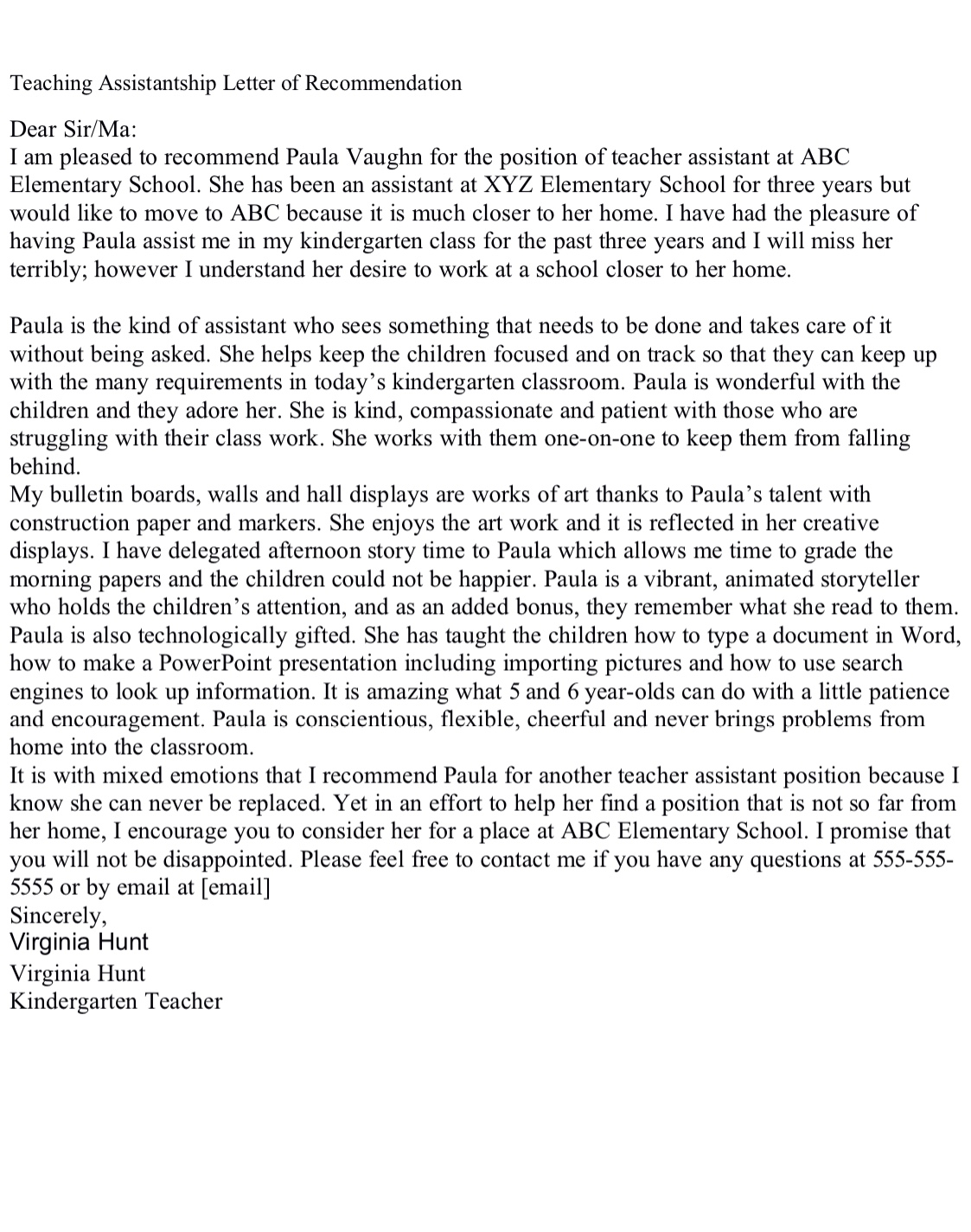
The same guide states that good reference letters also mention non-critical weaknesses and tend to attenuate or compensate them with positive details or facts.
Oftentimes, it is mentioning these weaknesses that creates the impression of honesty and objectivity.
However, as the guide from the University of North Carolina advises, you should mention the weaknesses that the audience would already be aware of.
If these are related to lower grades for certain subjects, explain the reason or state that the subject improved or has the potential to do so.
However, these weaknesses should only cover the professional dimension, not the personal one.
The letter should avoid informal language, inappropriate humor, slang, casual language – use business or academic language instead. The text should be free of grammar and spelling mistakes, it should be well-structured, with a good flow and layout, and should use proper wording.
It is generally inappropriate to mention the candidate’s race, ethnicity, religion, political preferences, age, health or marital status since reference letters should assess professional qualities.
Also, pay attention to language that might introduce gender or other biases. Thus, evidence shows that women are more likely to be portrayed with qualifiers that are irrelevant to their professional skills.
Avoid clichés and generalizations like “hard-working,” “dedicated,” and “enthusiastic” – to describe these qualities, it is always better to employ powerful anecdotes and vignette.
Don’t abuse the number of compliments and stay away from exaggerated, awkward, or half-hearted compliments.
The latter can be interpreted as “I didn’t find anything better to say about the candidate”.
How to Use Examples of Letters of Recommendation Online
There are plenty of free samples online to help with your first recommendation letter. However, you must be careful not to copy them.
Every reference letter is unique to each applicant. Do your best to tailor your LOR to suit your candidate’s needs.
Below, you can also find 2 excellent reference letter examples you can use for various occasions.
More Sample Letters of Recommendation
Written by a Manager for a freelance worker
Anna Fields
Chief Operating Officer
Windberg, Inc.
13 Vermont Lane
Portland, Oregon 97206
Dear Ms. Fields,
I’m very pleased to recommend Kara for the position of Web Designer with Windberg, Inc. Kara has worked with our accessory company, Sundial Co., on a freelance basis over the past several years. While I’ve communicated with Kara remotely via video chat and email, I’ve gotten to know her as a reliable employee with substantial web design skills. I have no doubt that she’ll continue to create outstanding work as a full-time web designer with your company.
Kara began contributing to our company over five years ago. She started with us during a major push to rebrand and worked on design across the site. Kara elevated our company’s aesthetic by redefining our design across our website pages. In fact, she updated our logo, which we use across all our pages and email newsletters. She’s fluent in HTML, CSS, and JavaScript and has experience with website builders, like WordPress and Wix. Kara has an artistic eye and a keen sense of user experience. We owe a great deal of the appeal and ease of use of our new website to Kara’s efforts.
In addition to working on front end design, Kara also worked across our social media platforms. She helped shape our Instagram, Facebook, Twitter, and Pinterest pages and engage users with viral content. She was especially skilled with curating content on Instagram and Pinterest. Most recently, she put together a style story on one of our jewelry designers, a feature that’s gotten over 2,000 shares. Between her strong sense of aesthetics and attention to detail, Kara was able to create a sleek visual experience that drew in customers and boosted sales.
While Kara has been a great talent on our team, she seeks to work for a cause which she’s passionate about – environmental protection. She’s excited about Windberg’s mission to make alternative energy affordable to the average consumer. I’m excited she’s found this opportunity to apply her expertise as a web designer to a cause that’s so close to her heart.
Kara is a creative, detail-oriented, and savvy web designer with a passion for the solar and renewables industry. She’s great at working independently and can produce high-level work with little supervision. I have no doubt that she will make an excellent addition to the Windberg team. Please feel free to contact me with any questions. Thanks for your time.
Sincerely,
Sample B
Edmund Hefner
Web Design Director
Sundial Co.
edmundhefner@sundial.com
444-444-4444
Sample letter #5
Written by a supervisor for an employee to facilitate an internal promotion
Abraham Mendes
Director of Customer Relations
GrimStrikes
65 Elm Road
Denver, CO 80014
Dear Mr. Mendes,
It’s my pleasure to provide this recommendation for Emilia as she pursues the Customer Experience Team Lead position with GrimStrikes. As her supervisor on the customer service team for the past four years, I’ve worked closely with Emilia on a day-to-day basis. I’m confident that Emilia is ready to transition into a leadership position. Please allow me to give a couple of examples of Emilia’s qualifications for this promotion.
Firstly, Emilia embodies our “customer-centric” philosophy and delivers an extraordinary shopping and ownership experience to our clients. She has impressed me with her warmth and kindness online, over the phone, and in person. For example, she showed on multiple occasions her ability to relate to our customers, consoling as well as educate them on company’s product and services.
Secondly, Emilia has an in-depth knowledge of our products and operating procedures. After four years on the support team, she’s dealt with a variety of issues and understands the day-to-day operations and big picture aims of our business. She can solve problems fast and has introduced several new initiatives for improvement. Recently, she began working on a new framework to facilitate communication between the support team and the product team. Emilia is improving the delivery of case notes from support representatives to product designers. She uses her in-depth knowledge to drive innovation.
Thirdly, Emilia has shown leadership skills throughout her time with GrimStrikes. Her colleagues recognize her as an expert in all things support, and they often go to her with questions. In the past year, she’s helped with the onboarding of several new employees, assisting with training and checking in weekly to discuss their progress. Since new employee onboarding will be a large part of her role as Customer Experience Team Lead, Emilia has already proven her capability in this area. I know that she has her colleagues’ support in stepping into the role of team leader.
Emilia has proven her expertise in customer relations time and time again, and she is ready to move into a position of team leadership. She is capable, confident, and committed to our mission of extraordinary support. I look forward to seeing her in the position of Customer Experience Team Lead with GrimStrikes. Thank you very much. Please feel free to get in touch with any questions.
Sincerely,
Edna Wallaby
Customer Experience Manager
GrimStrikes
ednawallaby@grimstrikes.com
666-666-6666
Conclusions
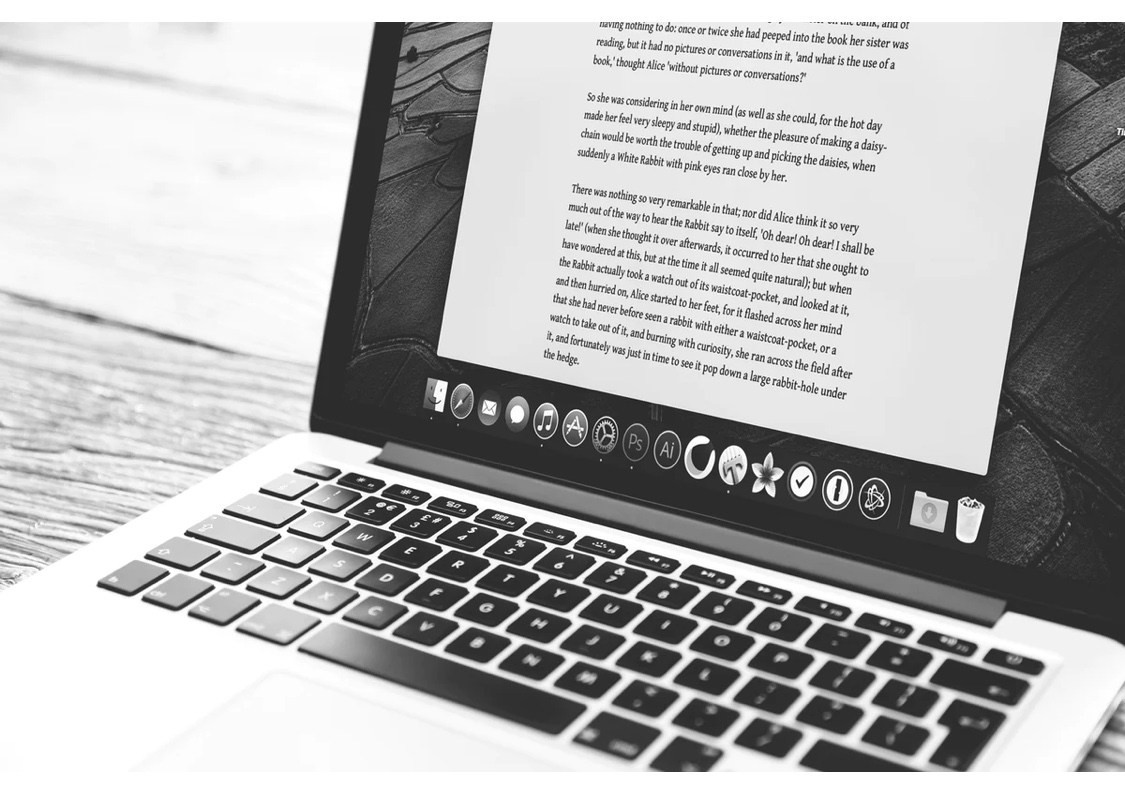
Writing a reference is a complex process that requires sufficient time, personal involvement, and effort. However, given the importance of this document for the future of the candidate, the referee has a moral obligation to take it seriously.
The reference letter for a college or job application should highlight the candidate’s accomplishments, professional qualifications, and personal traits that are relevant to the position he or she is applying for. In doing so, it is essential to identify the good qualities of the candidate and portray the latter from a positive angle. The extent to which this portrait manages to be comprehensive, positive, and credible will determine the strength of the recommendation letter.
The process of writing a recommendation letter is a responsible and thoughtful task that has a significant impact on a student’s future. Your every word could be the key to opening a new chapter for a student. The effort put into this process deserves recognition and gratitude.
As a token of your selfless support, students may choose to send you a beautiful pen like Custom Pens Low Minimum. Not only does it represent gratitude for the time and effort you put into writing the recommendation letter, but it also represents good wishes for future success.
When you pick up this pen at some point in the future, it will become a treasured souvenir on your bookshelf. It will not only remind you of the special place you occupy in your student’s heart but also symbolize the important role you play in their life journey.
Have you ever written a letter of recommendation for a college student or a former colleague/employee?
How did you go about it? What challenges did you face? How did you overcome these challenges?
Which of these sample letters of recommendation appealed to you the most? Please share your thoughts in the comment section below.
Author’s Bio:
Bridgette Hernandez:
Bridgette is a content writing specialist who works for students and with students. She teaches them how to write formal or creative texts and how to overcome common challenges in order to unlock their full writing potential.
Right now, she is working on turning this helpful site into a vast freely accessible database of essays on a great variety of topics.
Bridgette also likes to explore the tricks and techniques that can boost creative and prolific writing. She also likes to reflect and how these could be implemented in a mass education setting.


